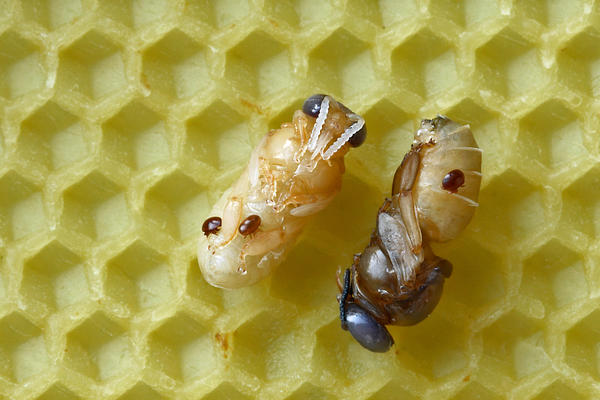Archives – June, 2017
From: Vermont Public Radio
By Patrick Skahill
***
Then, there’s the varroa mite. Creighton said this parasite is the number one killer of bees in Connecticut. It feeds on bees, can cripple their newborns, and spreads disease, which honey bees can pass on to other pollinators at shared flowers.
“They impact our native bees,” Creighton said. “And we want to keep all our bees healthy — not just our Apis mellifera.”
 Varroa mites on pupae.
Varroa mites on pupae.
Listen/Read Complete Story
June 30, 2017
From: New York Ag Connection
A small mite is causing big trouble for New York’s honeybee population and putting in peril the fruit and vegetable crops that depend on these pollinators.
***
Even more alarming, according to Mullen, is that 78 percent of operations had varroa mite levels that exceeded the economic threshold of 3 mites per 100 bees, an important predicator that the colony will die within one to two years or experience reduced honey production. Surpassing that threshold demonstrates that the mites are not being managed effectively and are posing a critical risk to colony health, Mullen said.
June 29, 2017
The following is CRE’s presentation to USDA/NIFA’s Listening Session on its National Monitoring Plan for Native Bees. A pdf of CRE’s presentation is available here.
I. Core Issue: All models and datasets used to estimate native bee populations must comply with the Data Quality Act
II. Data Collection and Modeling is the Basis for Understanding Native Bee Populations
A. Data Collection
i. Robustness. The collected data needs to be robust.
ii. Inferences. The sample size needs to be large enough to permit knowledgeable inferences.
B. Models
i. DQA Requirements. The models need to comply with the transparency, reproducibility and other requirements of the Data Quality Act.
June 28, 2017
From: United States Department of Agriculture/National Institute of Food and Agriculture
“The National Monitoring Plan for Native Bees: Stakeholder and Public Listening Session Webinar” is the first step towards developing a national monitoring plan. The listening session will be held on Wednesday, June 28, 2017 from 8:00 a.m. to 3:30 p.m. and will gather input from a diverse range of people who are interested in native bee diversity, abundance, and large scale national monitoring strategies. Everyone is welcome to participate in the listening session by webinar. A few days before the event, NIFA’s Web site will include details about the webinar.
June 27, 2017
From: AP via Times-Picayune
BATON ROUGE — Two Louisiana State University researchers are getting nearly $1 million for a two-year study of how mite treatment and stress affect honeybee health.
Kristen Healy and Daniel Swale are working with U.S. Department of Agriculture researchers in Baton Rouge and the nation’s largest beekeeper, the LSU AgCenter said in a news release Thursday.
Read Complete Article
June 26, 2017
From: Yakima Herald
By Eric Olson
***
Here in Washington state, we’ve been making a major contribution to healthier bees since I helped kick-start Washington State University’s research program. Now WSU has a diagnostic lab to which beekeepers can send bee samples to be analyzed for disease and parasites. And recently, using our state’s abundant controlled atmosphere storage facilities, we’ve begun controlling varroa without chemicals, ‘suffocating’ them with carbon dioxide in these facilities while sheltering our bees from damaging winter weather. Varroa mites can’t develop resistance to not breathing!
June 26, 2017
From: United States Department of Agriculture | National Institute of Food and Agriculture
WASHINGTON, D.C. June 20, 2017 – The U.S. Department of Agriculture’s (USDA) National Institute of Food and Agriculture (NIFA) today announced seven grants totaling $6.8 million for research and extension projects to sustain healthy populations of pollinators, which are crucial to the nation’s food security and environmental health. The funding is made possible through NIFA’s Agriculture and Food Research Initiative (AFRI) program, authorized by the 2014 Farm Bill.
June 23, 2017
From: Growing Produce
Posted By: Christina Herrick
As the managed honey bee industry continues to grapple with significant annual colony losses, the Varroa destructor mite is emerging as the leading culprit. And, it turns out, the very nature of modern beekeeping may be giving the parasite the exact conditions it needs to spread nearly beyond control.
In an article recently published in the Entomological Society of America’s Environmental Entomology, researchers argue that the Varroa mite has “co-opted” several honeybee behaviors to its own benefit, allowing it to disperse widely even though the mite itself is not a highly mobile insect. The mite’s ability to hitchhike on wandering bees, the infections it transmits to bees, and the density of colonies in managed beekeeping settings, make for a deadly combination.
June 22, 2017
From: Bio Based Press | Towards green growth through sustainability and innovation
By: Diederik van der Hoeven
In three columns, I have investigated the question of bee colony collapse and neonicotinoids (neonics), the effect of pesticides on pollinating insects and natural pest predators, and finally the services that biodiversity renders to agriculture and the economy. I observed that a simple ‘allow or ban’ decision on neonics may not be adequate. What other mechanisms and possible outcomes do we have at hand in the regulatory process?
This is the final of four columns on neonicotinoids and their possible effects on bees, and on the wider issue of biodiversity and its importance to agriculture. Published on 2 May, 4 May, 15 May and 17 May 2017.
June 21, 2017
From: PeerJ | The award-winning biological and medical sciences journal
Larval exposure to field-realistic concentrations of clothianidin has no effect on development rate, over-winter survival or adult metabolic rate in a solitary bee, Osmia bicornis
Elizabeth Nicholls1, Robert Fowler1, Jeremy E. Niven1, James D. Gilbert1,2 and Dave Goulson1
June 20, 2017
Previous page
 Varroa mites on pupae.
Varroa mites on pupae.